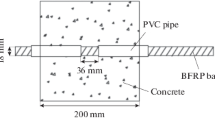Abstract
Strain rate effect as an important characteristic of concrete materials, the most research mainly focuses on mechanical properties but less for bond slip behavior. In order to understand the effect of loading rate on the bond slip process. Acoustic emission technology was applied to study damage mechanism for bond-slip behavior of basalt fiber reinforced concrete (BFRC) at different loading rates. The results show that higher loading rate helps to improve bond strength. At the same time, the acoustic emission characteristics have the same tread for BFRC at different loading rate, it mainly affects the activity and intensity magnitude without the distribution. The AE b value were used as the early warning indicator for BFRC were 0.5–1.0. The acoustic emission centroid frequency was an important acoustic emission characteristic parameter that characterizes the loading rate. Those conclusion could be used to evaluate the dynamic damage of BFRC structure.









Similar content being viewed by others
REFERENCES
Micelli, F., Nanni, A., Tensile characterization of FRP rods for reinforced concrete structures, Mech. Compos. Mater., 2003, vol. 39, no. 4, pp. 293–304.
Ceroni, F., Cosenza, E., Gaetano, M., et al., Durability issues of FRP rebars in reinforced concrete members, Cem. Concr. Compos., 2006, vol. 28, no. 10, pp. 857–868.
Wang, L., Mao, Y., Lv, H., et al., Bond properties between FRP bars and coral concrete under seawater conditions at 30, 60, and 80, Constr. Build. Mater., 2018, vol. 162, pp. 442–449.
Tighiouart, B., Benmokrane, B., and Gao, D., Investigation of bond in concrete member with reinforced polymer (FRP) bars, Constr. Build. Mater., 1998, vol. 12, no. 8, pp. 453–462.
Ayudhya, B. I. N. and Ungkoon, Y., Bond strength of fiber reinforced polymer (FRP) bars in autoclaved aerated concrete (AAC), in Adv. FRP Compos. Civ. Eng., Berlin–Heidelberg: Springer, 2011, pp. 585–588.
El-Nemr, A., Ahmed, E. A., Barris, C., et al., Bond-dependent coefficient of glass- and carbon-FRP bars in normal- and high-strength concretes, Constr. Build. Mater., 2016, vol. 113, pp. 77–89.
Zhang, H., He, L., and Li, G., Bond failure performances between near-surface mounted FRP bars and concrete for flexural strengthening concrete structures, Eng. Failure Anal., 2015, vol. 56, pp. 39–50.
Katz, A. and Berman, N., Modeling the effect of high temperature on the bond of FRP reinforcing bars to concrete, Cem. Concr. Compos., 2000, vol. 22, no. 6, pp. 433–443.
Galati, N., Nanni, A., Dharani, L. R., et al., Thermal effects on bond between FRP rebars and concrete, Composites Part A, 2006, vol. 37, no. 8, pp. 1223–1230.
Baena, M., Lluís, Torres, Turon, A., et al., Experimental study of bond behavior between concrete and FRP bars using a pull-out test, Composites Part B, 2009, vol. 40, no. 8, pp. 784–797.
Cosenza, E., Manfredi, G., and Realfonzo, R., Behavior and modeling of bond of FRP rebars to concrete, J. Compos. Constr., 1997, vol. 1, no. 2, pp. 40–51.
Kanakubo, T., Yonemaru, K., and Fukuyama, H., et al., Bond performance of concrete members reinforced with FRP bars, ACI Spec. Publ., 1993, vol. 138, pp. 767–767.
Vilanova, I., Baena, M., Torres, L., et al., Experimental study of bond-slip of GFRP bars in concrete under sustained loads, Composites Part B, 2015, vol. 74, pp. 42–52.
Alves, J., El-Ragaby, A., and El-Salakawy, E., Durability of GFRP bars’ bond to concrete under different loading and environmental conditions, J. Compos. Constr., 2010, vol. 15, no. 3, pp. 249–262.
Mirmiran, A. and Philip, S., Comparison of acoustic emission activity in steel-reinforced and FRP-reinforced concrete beams, Constr. Build. Mater., 2000, vol. 14, nos. 6-7, pp. 299–310.
Gallego, A., Benavent-Climent, A., and Suarez, E., Concrete-galvanized steel pull-out bond assessed by acoustic emission, J. Mater. Civ. Eng., 2016, vol. 28, no. 2, p. 04015109.
Kurz, J.H., Finck, F., Grosse, C.U., et al., Stress drop and stress redistribution in concrete quantified over time by the b-value analysis, Struct. Health Monit., 2005, vol. 5, pp. 69–81.
Chen, Yuzhi and Chen, Shije., Experimental study on AE characteristics of bond-slip for the reinforced concrete under the dynamic tensile, J. Appl. Acoust., 2017, vol. 36, no.4, pp. 343–348.
Standard C.S.A., Design and construction of building components with fibre-reinforced polymers, S806-02, Can. Stand. Assoc., 2002.
JCMS-III B5706. Monitoring method for active cracks in concrete by AE., Tokyo: Constr. Mater. Stand., 2003.
Ohno, K., and Ohtsu, M., Crack classification in concrete based on acoustic emission, Constr. Build. Mater., 2010, vol. 24, pp. 2339–2346.
Ohtsu, M. and Tomoda, Y., Corrosion process in reinforced concrete identified by acoustic emission, Mater. Trans., 2007, vol. 48, no. 6, pp. 1184–1189.
Chen, Y. Z. and Chen, S.J., Experimental Study on Acoustic Emission Characteristics of Bond-Slip for BFRP Concrete, Russ. J. Nondestr. Test., 2020, vol. 56, no. 2, pp. 119–130.
Carpinteri, A., Lacidogna, G., and Manuello, A., The b-value analysis for the stability investigation of the ancient Athena temple in Syracuse, Strain, 2011, vol. 47, p. s1.
Carpinteri, A., Lacidogna, G., and Niccolini, G., Damage analysis of reinforced concrete buildings by the acoustic emission technique, Struct. Control Health Monit., 2011, vol. 18, no. 6, pp. 660–673.
Aggelis, D.G., Soulioti, D.V., Sapouridis, N., et al., Acoustic emission characterization of the fracture process in fibre reinforced concrete, Constr. Build. Mater., 2011, vol. 25, no. 7, pp. 4126–4131.
Funding
The research is based upon work support by the Natural Science Foundation of Jiangsu Province (Grant no. BK20181114).
Author information
Authors and Affiliations
Corresponding author
Rights and permissions
About this article
Cite this article
Chen, Y., Chen, S. Acoustic Emission Characteristics of Bond-Slip for BFRP Concrete at Different Loading Rates. Russ J Nondestruct Test 56, 1030–1041 (2020). https://doi.org/10.1134/S1061830921010046
Received:
Revised:
Accepted:
Published:
Issue Date:
DOI: https://doi.org/10.1134/S1061830921010046




